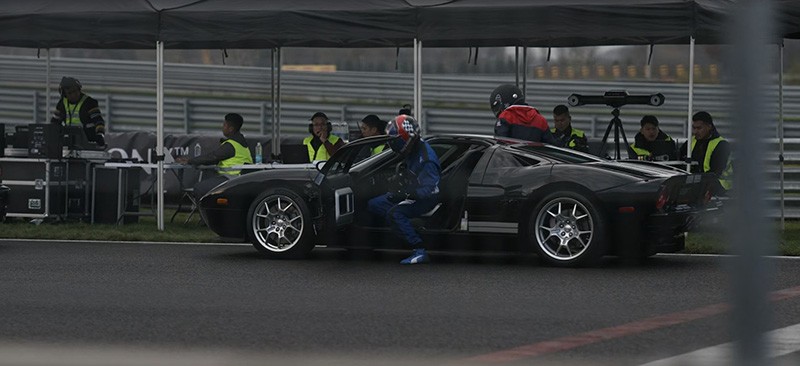The release of the movie Gran Turismo in August 2023 highlighted the increasing realism in racing games. A key factor in achieving this level of immersion is the meticulous detail of the vehicles, and Polyphony Digital’s use of Scantech’s TrackScan-P 3D Scanning System to digitize real-world cars showcased the power of advanced technology in bridging reality and virtual gaming. This innovative approach is particularly crucial when it comes to incorporating classic cars into modern racing games.
Today’s racing game enthusiasts demand unparalleled realism, with cutting-edge graphics and physics engines delivering incredibly lifelike driving experiences. While modern supercars are readily available in digital form, the allure of classic cars presents a unique challenge for game developers. These historical vehicles, with their timeless designs and rich heritage, offer a captivating element to racing games. However, creating accurate digital models of these vintage automobiles is not straightforward due to the absence of original digital blueprints and the unique contours shaped by time and craftsmanship. This is where 3d Scanning Classic Cars emerges as a game-changing solution.
The Challenge of Digitizing Classic Cars
Bringing classic cars into the digital realm for racing games requires overcoming significant hurdles. Unlike contemporary vehicles designed with CAD software, classic cars were often handcrafted, with designs existing primarily as physical objects. Digitizing these vehicles necessitates capturing every curve, dent, and detail with utmost precision. Game developers face several key challenges when aiming to create virtual classic cars that resonate with authenticity:
- Accuracy and Detail: Capturing the intricate details of classic car exteriors and interiors is paramount. Players expect to see every nuance reflected in the digital model, from the body lines to the stitching on the seats.
- Handling Imperfections: Classic cars are not factory-perfect; they bear the marks of time, repairs, and unique histories. A truly realistic digital representation should capture these imperfections, adding to the vehicle’s character and authenticity.
- Efficiency: The process of digitizing a car needs to be efficient to fit within game development timelines. Traditional methods of manual modeling are time-consuming and may lack the precision required for photorealistic results.
- Access to Confined Spaces: Scanning the interiors of classic cars often involves navigating tight spaces, requiring specialized equipment capable of capturing data in restricted areas.
Scantech 3D Scanning Solutions: Precision and Efficiency
Scantech offers advanced 3D scanning technology that directly addresses these challenges, making 3d scanning classic cars for racing games a viable and efficient process. Their TrackScan series, particularly the TrackScan-Sharp, and the SIMSCAN series are ideally suited for this task.
TrackScan-Sharp for Exterior Excellence:
The TrackScan-Sharp is engineered for rapid and comprehensive data capture of large objects. Its expansive measuring volume dramatically reduces the need for scanner repositioning, accelerating the scanning process for car exteriors. The ability to capture large sections of the car in a single scan ensures efficiency without compromising detail. Sophisticated software seamlessly stitches together individual scans, creating a cohesive and highly accurate 3D model ready for integration into game engines. The marker-free tracking capability is particularly valuable for preserving the pristine surfaces of museum-quality classic cars, as demonstrated in the original article’s case study.
SIMSCAN 30 for Intricate Interiors:
For the complex interiors of classic cars, the SIMSCAN 30 handheld 3D scanner provides unparalleled access and precision. Its compact design and narrow view angle allow it to navigate tight spaces such as dashboards, footwells, and seating areas with ease. This capability is crucial for capturing the intricate details of classic car interiors, which are often as important to the overall experience as the exterior. The SIMSCAN 30’s ability to capture data in confined spaces ensures that no detail is missed, resulting in a complete and accurate digital representation.
Case Study: Digitizing the Opel Manta
As highlighted in the original article, Scantech’s technology, in collaboration with IBS Quality GmbH, was instrumental in digitizing a vintage Opel Manta for a game developer. The project demanded capturing both the flawless beauty and the age-related imperfections of the car. Using the TrackScan-Sharp for the exterior and SIMSCAN 30 for the interior, the team successfully created a “digital twin” of the Opel Manta. The marker-free scanning of the TrackScan-Sharp ensured rapid exterior data acquisition, while the SIMSCAN 30 expertly handled the challenges of the car’s interior, demonstrating the effectiveness of Scantech’s dual-scanner approach for 3d scanning classic cars.
Benefits of 3D Scanning Classic Cars for Gaming
The adoption of 3d scanning classic cars offers significant advantages for the gaming industry:
- Enhanced Realism and Immersion: 3D scanning delivers unparalleled accuracy, resulting in highly realistic and immersive in-game car models. This level of detail elevates the player experience, making virtual classic car ownership truly compelling.
- Preserving Automotive Heritage: By digitizing classic cars, game developers contribute to the preservation of automotive history. These digital models ensure that future generations can experience the beauty and craftsmanship of these vehicles in a virtual environment.
- Streamlined Content Creation: Compared to manual modeling, 3D scanning significantly accelerates the content creation pipeline. This efficiency allows developers to include a wider range of classic cars in their games, enriching the gaming experience.
- Authenticity and Emotional Connection: Capturing the imperfections and unique characteristics of each classic car through 3D scanning adds a layer of authenticity that resonates with players, fostering a deeper emotional connection with the vehicles.
3d scanning classic cars is revolutionizing the way classic vehicles are represented in racing games. Scantech’s advanced 3D scanning solutions provide the accuracy, efficiency, and detail necessary to bring these automotive icons to life in the digital world, offering gamers unprecedented realism and a chance to experience automotive history firsthand. Ready to explore the possibilities of 3D scanning for your game development? Click here to discover Scantech’s range of 3D scanners.


